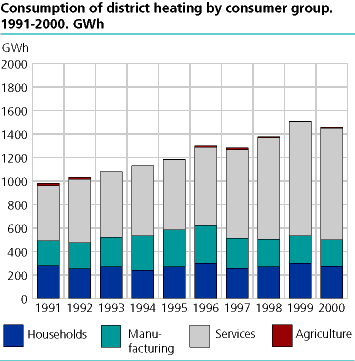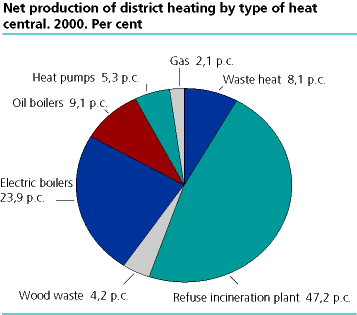Content
Published:
This is an archived release.
Lower consumption of district heating
After record high consumption of district heating in 1999, 2000 saw a 3.4 per cent reduction in district heating consumption compared with the year before. Consumption of district heating last year was 1 457 GWh. Milder weather in 2000 explains some of the decline.
Households, which account for 18.9 per cent of district heating consumption, saw the biggest decline. Their consumption fell 7.6 per cent, to 276 GWh in 2000. By far the biggest consumption group, service industries, reduced their consumption of district heating last year by 2.5 per cent, to 947 GWh. District heating consumption in manufacturing was 225 GWh in 2000, down 3.3 per cent. District heating accounts for about 2 per cent of energy deliveries for heating purposes in Norway. The corresponding share in Denmark and Sweden is around 50 and 35 per cent.
Higher prices yield higher sales revenues
Despite lower consumption of district heating, revenues from the sale of district heating increased. Sales revenues increased by NOK 24 million, to NOK 445 million in 2000. This is because of higher prices for district heating. Last year, the average price of district heating was 30.6 øre/kWh, excluding VAT. This is an increase of fully 9.5 per cent from 1999. From 1987 to 2000 prices grew an average of 5.7 per cent annually. By comparison, the average annual increase in the consumer price index was 3 per cent during the same period.
The cost of burning fuel in district heating plants increased by almost NOK 39 million from 1999 to 2000, more than eating up the higher sales revenues.
More use of electric boilers
Lower electricity prices and higher prices of oil products prompted district heating producers to substitute oil-fired boilers with electric boilers. The system price for electricity at Nord Pool ASA was reduced from 11.2 øre/kWh in 1999 to 10.3 øre/kWh in 2000, a decline of 7.8 per cent. The list price of domestic heating oil increased according to the Norwegian Petroleum Institute from 326 øre/litre to 421 øre/litre, excluding VAT. The increase was thus 29 per cent. Net production of district heating from electric boilers increased from 77 GWh in 1999 to 384 GWh in 2000. Correspondingly, net production of district heating from oil-fired boilers was reduced from 510 GWh in 1999 to 147 in 2000.
Overall net production of district heating was 1 605 GWh last year. This is 2.8 per cent lower than the year before. Nearly half of district heating production comes from waste incineration.
Increased investments
Investments in district heating last year totalled NOK 236 million. This is 7.3 per cent more than the year before. On average, the annual growth in investments since 1994 has been 38.3 per cent. Investments in production plants accounted for about half of the investments in 2000, while investments in distribution plants and other facilities accounted for the rest.
Tables:
Contact
-
Ann Christin Bøeng
E-mail: ann.christin.boeng@ssb.no
tel.: (+47) 40 81 13 58


